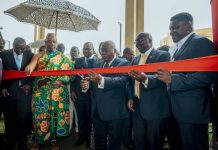JOHANNESBURG, South Africa, April 25, 2022/ — While Angola takes the place as the third-largest oil producer in Africa – with production measured at 1.14 million barrels per day in 2021 – the country has also recently made headway in mineral wealth extraction.
In 2022, the Ministry of Mineral Resources, Oil and Gas is focused on driving mineral-related development and deals on the back of economic diversification targets. As the country celebrates the 37th anniversary of Mining Labor Day on April 27 this year, several developments across the mining and strategic mineral industries have taken the spotlight.
Transforming the Diamond in the Rough
H.E. Diamantino Azevedo, Angola’s Minister of Mineral Resources, Oil and Gas, has emphasized that the country is well on its way to becoming the second-largest producer of rough diamonds globally by 2030.
Owing to significant developments across the diamond space, as well as market-driven regulatory reforms enabling investment in the sector, Angola is accelerating diamond mining activities in 2022 and beyond.
Currently, the country serves as the fourth-largest diamond producer globally, with production estimated at 9.3 million carats in 2021. However, approximately 60% of the country’s basins remain unexplored, thus opening up critical opportunities for further exploration.
With production targets set for 10.3 million carats in 2022, reforms such as the creation of an agency that serves as national concessionaire; the approval and implementation of Presidential Decree no. 143/20 – a governance model to increase efficiencies in the mining sector through the reduction of the State’s participation; the optimization of the role of the private sector; the promotion of transparency in the sector; and fiscal incentives to boost exploration, have already piqued the interest of global investors.
In December 2021, global diamond company, De Beers, announced its application to explore Angola’s northeastern region. With the Ministry pushing state-owned diamond company Endiama to pursue partnerships and deals with other global giants, the country is set to see rapid growth across its diamond industry.
Meanwhile, the Ministry remains focused on improving the domestic mining sector in a bid to ramp up economic and industrial development in Angola. Through local content policies and the drive for a local production and manufacturing industry in Angola, the country aims to improve job creation, industrialization and infrastructure development. Notably, with 95.5% of rough diamonds exported, the Ministry announced plans to cut 20% of diamonds domestically; launched the $77-million Saurimo Diamond Development Hub in 2021 – a project that unites the entire diamond value chain – and launched a diamond cutting and polishing training center to improve capacity building and skill transfer.
Accordingly, Angola has made, and continues to make, significant progress to up-skill the local mining workforce, an achievement that will be celebrated during this year’s Mining Labor Day.
Enabling Africa’s Energy Transition
That said, Angola’s existing mineral achievements and future potential go beyond diamonds, with the country’s wider mineral and rare earth market going from strength to strength each year. In addition to diamonds, Angola is rich in iron ore, phosphates, copper, gold and manganese. On the gold front, the country currently has 28 gold mining projects, 20 of which are in the prospecting phase, with average production capacity at each mine estimated at 4.5 kg per month. However, it is the country’s energy transition-related minerals that are likely to see an uptick in foreign investment.
As global priorities shift and new technologies such as electric vehicles (EV), battery storage and green energy take preference, rare earth minerals found in countries such as Angola are expected to play a critical role. The energy transition has heightened the demand for minerals such as lithium, nickel, cobalt, manganese and graphite, crucial for battery performance, as well as neodymium and praseodymium (NdPr), crucial for wind turbines and EV production.
In Angola, a country rich in these very minerals, significant developments are underway to ensure the country emerges as a global producer in this regard. Notable developments include the constitution’s approval of the Longonjo Project – set to become the first large-scale NdPr rare earths mine in Africa with production targets of 56,000 tons per year; Minbos Resources securing a mining license for the Cabinda phosphate project in 2021; and Anglo-American signing five contracts for mineral exploration and extraction in Angola in 2021, among others.
By targeting investment and development within the rare earth and minerals sector, Angola is focused on becoming the premier supplier of energy transition-related minerals.
Established by the then-Defense and Security Council, Mining Labor Day recognizes the role that mining workers play in transforming Angola’s mining sector and overall economy. As the country celebrates its 37th anniversary, global investors, regional stakeholders, and Angolan mining companies turn to both new and existing opportunities across the burgeoning Angolan mining sector.









































